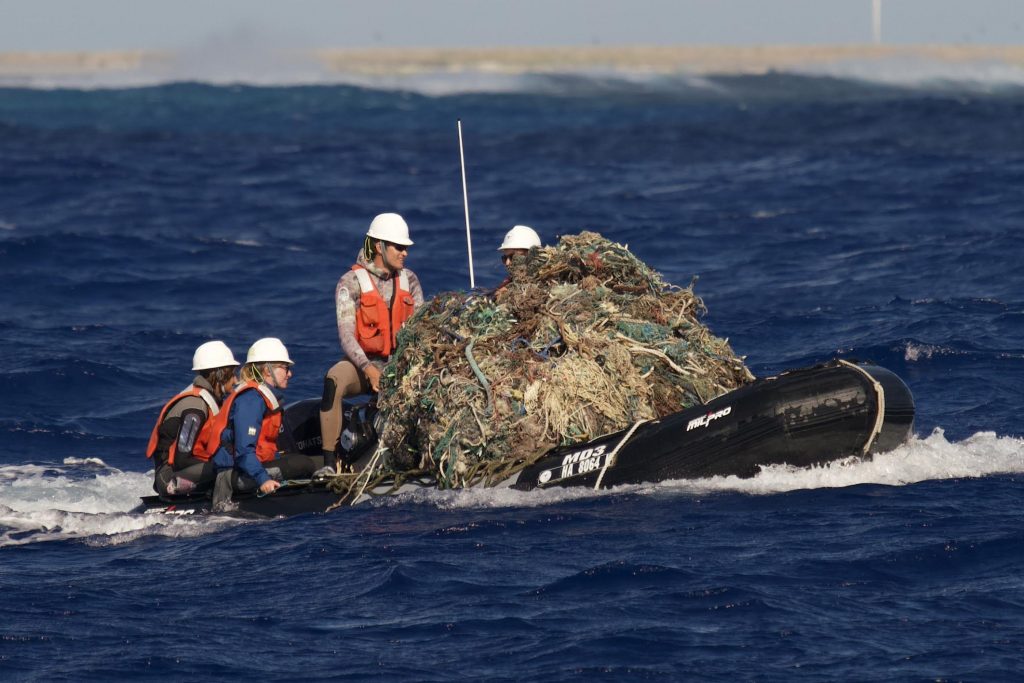53 tons of marine debris removed from national monument in Northwestern Hawaiian Islands
The second large-scale cleanup at Papahānaumokuākea Marine National Monument in the Northwestern Hawaiian Islands yielded 53 tons of marine debris.
The debris was removed from reefs and beaches of the islands and atolls.
The project was led by a 16-person team from the Hawaiʻi-based nonprofit organization Papahānaumokuākea Marine Debris Project.
The 16-person team returned to Honolulu recently — aboard the 185-ft ship M/V Imua — after their second 30-day large-scale cleanup expedition to Papahānaumokuākea in 2022.
This year’s cumulative total of marine debris removed is 202,950 pounds, the equivalent weight of 10 full-size school buses or greater than three humpback whales.
The most recent haul also brings the organization’s total to a half-million pounds of debris removal since they began large-scale cleanups two years ago.
In addition to removal of ghost nets and ocean plastics, on this mission the team also tackled the salvage of a derelict vessel that had been beached at Manawai (Pearl and Hermes Atoll) for more than a year.
The vessel, a lifeboat from the 650-ft car-carrier ship Sincerity Ace, was cast adrift in the vicinity of Papahānaumokuākea after a disastrous onboard fire resulted in the ship being abandoned on the high seas in January 2019.
During their latest cleanup efforts, the team recovered the following:
- 64,000 pounds of ghost net removed from the reefs
- 32,530 pounds of ghost net removed from the shorelines
- 9,125 pounds of ocean plastic debris removed from the shorelines
Using their team of highly-skilled freedivers, the Papahānaumokuākea Marine Debris Project conducted cleanups at Kapou (Lisianski Island), Manawai (Pearl and Hermes Atoll), Kuaihelani (Midway Atoll) and Hōlanikū (Kure Atoll), focusing on cutting ghost nets from the coral reefs.
The team successfully cleaned and restored more than 1,600 acres of shallow (less than 30-foot depth) coral reefs, greater than three times the size of Diamondhead Crater, while also saving two Hawaiian green sea turtles entangled in ghost nets.
The lifeboat had been aground on one of Manawai’s most pristine islets since at least June 2021, and posed an entrapment threat to seabirds and a contamination threat from the diesel fuel, batteries and engine fluids that were aboard.
The Papahānaumokuākea Marine Debris Project team, using sand anchors and pulleys, was able to winch the boat higher onto the beach where they repaired large gashes in the fiberglass hull before winching it back into the water and towing it 5 miles offshore to the waiting M/V Imua.
An estimated 57 tons of marine debris accumulates on the reefs of Papahānaumokuakea each year. 2022 marked year one of the organization’s strategic 5-year plan to “catch up” with backlogged accumulation and “keep up” with new annual influx.
Through intensive removal, this ambitious goal aims to reduce the impacts of marine debris to their lowest practicable levels, giving the wildlife of the marine monument the best long-term chance of survival.
The mission was supported by Marc and Lynne Benioff, the National Fish and Wildlife Foundation, NOAA Office of National Marine Sanctuaries, NOAA Marine Debris Program, U.S. Fish and Wildlife Service, the McPike-Zima Foundation and numerous community donors. NOAA support includes funding from the 2022 Bipartisan Infrastructure Law.
Sponsored Content
Comments














